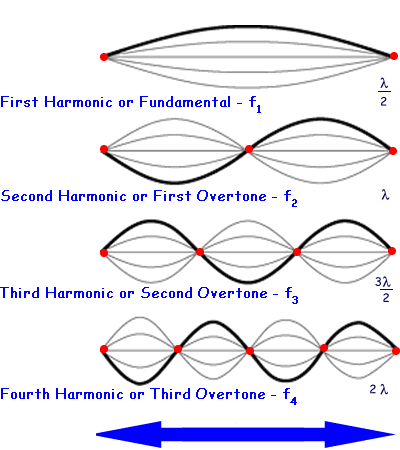

That is the fundamental, or first harmonic. Where do the harmonics, and the timbre, come from? When a string vibrates, the main pitch you hear is from the vibration of the whole string back and forth. Do any of the instruments actually make you think of specific shades of color, like fire-engine red or sky blue? For each instrument, what "color" words would you use to describe the timbre of each instrument? Use as many words as you can that seem appropriate, and try to think of some that aren't listed above. Some suggestions: an unaccompanied violin or cello sonata, a flute, oboe, trumpet, or horn concerto, Asaian or native American flute music, classical guitar, bagpipes, steel pan drums, panpipes, or organ. Listen to recordings of different instruments playing alone or playing very prominently above a group. The words musicians use to describe timbre are somewhat subjective, but most musicians would agree with the statement that, compared with each other, the first sound is mellow, the second bright, and the third rich. Now listen to the same phrase played by an electric guitar, an acoustic guitar with twelve steel strings and an acoustic guitar with six nylon strings. Although these instruments are quite similar, the viola has a noticeably "deeper" and the violin a noticeably "brighter" sound that is not simply a matter of the violin playing higher notes. Listen to recordings of a violin and a viola. Some other words that musicians use to describe the timbre of a sound are: reedy, brassy, piercing, mellow, hollow, focussed, transparent, breathy (pronounced BRETH-ee) or full. It can be heavy, light, dark, thin, smooth, murky, or clear. Like a color you see, the color of a sound can be bright and bold or deep and rich. This difference in the sounds is the color, or timbre (pronounced "TAM-ber") of the notes. It is still easy to tell the two notes apart, because an oboe sounds different from a flute. Then a flute plays the same note at the same dynamic level as the oboe. What is the color of a sound? Say an oboe plays a middle C. Instead, the harmonics give the note its color. These different pitches are called harmonics, and they are blended together so well that you do not hear them as separate notes at all. Each note that comes out of the instrument is actually a smooth mixture of many different pitches. When someone plays or sings a musical tone, only a very particular set of frequencies is heard. The shorter the wavelength, and higher the frequency, the higher the note sounds.


 0 kommentar(er)
0 kommentar(er)
